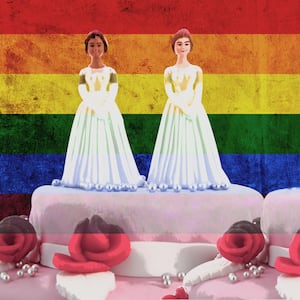On June 28, 1969, sodomy was illegal in New York. So was “lewd conduct,” the broad offense that, like a dragnet, caught thousands of gay men and lesbians who might be drinking, dancing, or socializing together; and “disorderly conduct,” which could mean just about anything—then and now.
Those were the legal pretexts for the Stonewall Riots that began that night—some of them, anyway. (Inspector Seymour Pine of the NYPD raided the bar because it was brazenly defying the city’s liquor laws, protected by Mafia connections and police payoffs.)
But they were just pretexts. Everyone knew why paddy wagons were so common outside gay bars in New York: harassment, intolerance, and publicity. 1969 was a mayoral election year, after all. What better way to curry favor with the conservatives on the Upper East Side than rounding up a few more degenerates down in Greenwich Village?
Laws aren’t only pretexts, though. They’re also symbols—symbols of what a society tolerates and what it abhors, who has status and who does not.
That’s why, 50 years later, there are headlines about wedding cakes and recalcitrant clerks in Kentucky. No one cares about the wedding cake, or the photographs, or the flowers. Certainly no one cares about the clerk; Kim Davis has plenty of colleagues who can sign the damn marriage certificate that she is too pure to approve.
No, we care about the symbols. About “No Gays Allowed” signs, redolent of Jim Crow. About the fact that, in 2019, my daughter can legally be refused medical care in an emergency room because she happens to have two dads. We care about what these things say about us, and what they do.
Since Stonewall, the legal process of LGBTQ people in this country has been objectively astonishing. Just 17 years after the trans women, drag queens, and other “degenerates” fought back against Inspector Pine and his men, a team of lawyers argued before the Supreme Court that what gay people do in the bedroom is no business of the government’s.
That’s what “right to privacy” really means, after all: that the government has no business being in your bed—or your uterus.
Those lawyers lost by a single vote, cast by Justice Lewis Powell, who later regretted voting as he did but said that maybe it didn’t matter that much, since after all no one gets prosecuted for sodomy anyway.
But Justice Powell was wrong. It did matter, because laws are symbols as well as regulations. If 24 states (at the time) can criminalize gay sex, then surely it’s OK for kids to call me faggot on the school bus. (Which they often did.)
That’s why marriage matters, too. I’m sympathetic to the radical critiques of same-sex marriage. That it props up a crappy, patriarchal institution conceived in sexism and still used to marginalize relationships that the majority happens to dislike. That it’s assimilationist in the extreme. That it does nothing for transgender folks. That it’s a lot less important, practically speaking, than ensuring access to employment, healthcare, or basic safety.
I’m on board with these critiques, but the right to marry, won in 2015, was still worth fighting for. Yes, sodomy had been decriminalized—in 2003 if not 1986. Yes, there had been same-sex marriage in some states since that same year. But just as the raid on Stonewall was a societal symbol couched in the operations of the law, the victories of Windsor and Obergefell were as well.
It’s worth remembering what those cases said. Sometimes they’re just seen as victories of a social movement—which they are, of course—in its progress toward full equality. Left and right alike see Supreme Court cases this way, whether in the areas of religion, sexuality, free speech, or anything else.
But that’s not quite right, legally speaking.
What constitutional cases like these say is that the right in question is, contrary to appearances and history and tradition, already part of what it means to be an American. It means that, for perhaps two hundred years, we have misunderstood the core guarantees of American citizenship.
Windsor, Obergefell, and, for that matter, Roe v. Wade and Brown v. Board of Education, weren’t policy decisions by a legislature. It’s not that we all thought one way, but now we’ve changed our minds. It’s that the Supreme Court, charged with interpreting the Constitution, has recognized that our American experiment is always a work in progress. We don’t get it right the first time. In fact, as with slavery and Jim Crow, we often get it horribly, tragically wrong.
These constitutional cases are calls to live by our core principles. When it comes to some matters of human intimacy, there can be no “due process” by which the government can take your liberty away. The constitution’s guarantees of equal protection, combined with what we now understand about human sexual identity, mean that the right to marry belongs to everyone, gay and straight alike.
In other words, the symbol and the principle converge.
Symbolically, same-sex marriage is about a very simple question: Is it OK to be gay? Put more fully, is my sexuality a proclivity to commit a crime, or is it one of the countless variations in human nature that enriches, not diminishes, my humanity? And is it the government’s business to decide?
These are also the constitutional questions that LGBTQ cases since Stonewall have asked. Are gay people simply people who happen to engage in improper and punishable activities? Or are we people, with our sexualities, rights, and liberties intrinsic to our identities?
And these are the questions now being asked as these hard-won rights are being eroded, both piecemeal by “religious exemptions” and perhaps wholesale, by a newly conservative judiciary with inadequate respect for precedent. These conservative reactions aren’t really about religious freedom or constitutional interpretation. They’re about, once again, the reality and dignity of queer identity.
Really, they’re not that different from June 28, 1969.


